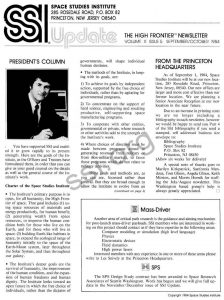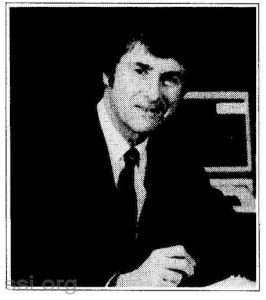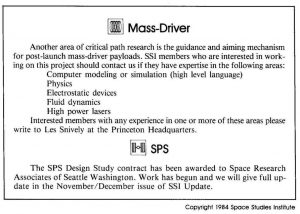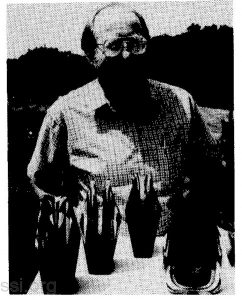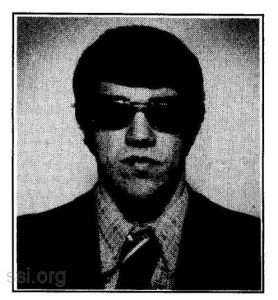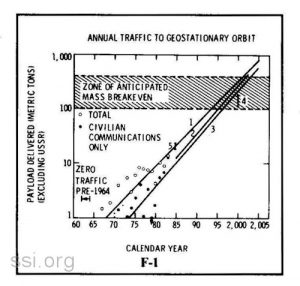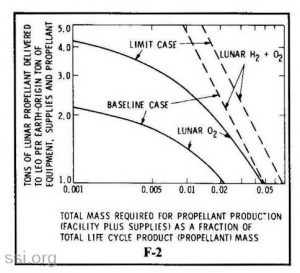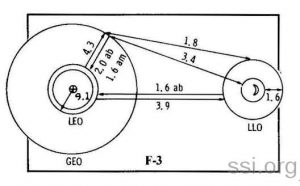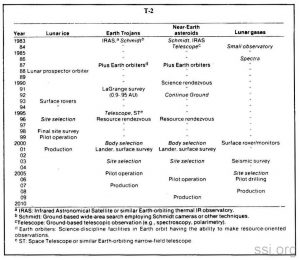SPACE STUDIES INSTITUTE
285 ROSEDALE ROAD, P.O.Box 82
PRINCETON, NEW JERSEY 08540
[[librarian note: This address is here, as it was in the original printed newsletter, for historical reasons. It is no longer the physical address of SSI. For contributions, please see this page]]
SSI UPDATE
THE HIGH FRONTIER(sm) NEWSLETTER
VOLUME X ISSUE 5
SEPTEMBER/OCTOBER 1984
PRESIDENT’S COLUMN
You have supported SSI and enabled it to grow rapidly to its present strength. Here are the goals of the Institute, as the Officers and Trustees have formulated them, in order that you can give us your good counsel on the details as well as the general course of the Institute’s work.
Charter of the Space Studies Institute
• The Institute’s primary purpose is to open, for all humanity, the High Frontier of space. That goal includes (1) using space resources of materials and energy productively, for human benefit; (2) generating wealth from space resources, to improve the human condition both for those who live on the Earth, and for those who will live in space; (3) building Earth-like habitats in space, to expand the ecological range of humanity initially to the space of the Earth-Moon system, later throughout the Solar System, and then throughout our galaxy.
• The Institute’s deeper goals are the survival of humanity, the improvement of the human condition, and the expansion of human freedoms and human dignity. The Institute looks toward an open future in which the free choice of individuals, rather than the dictates of governments, will shape individual human destinies.
• The methods of the Institute, in keeping with its goals, are:
1) To achieve its goals by independent action, supported by the free choice of individuals, rather than by agitating for governmental programs.
2) To concentrate on the support of hard science, engineering and resulting productive, self-supporting space manufacturing programs.
3) To cooperate with other entities, governmental or private, whose research or other activities add to the strength of the Institute’s work.
4) Where choices of direction must be made between programs aimed at generating revenues from military or from non-military markets, to favor those programs which do not relate to military activities.
These goals and methods are, as you can see, focussed rather than general. But they are broad enough to allow the Institute to evolve from an organization supporting research to an organization carrying out action programs opening the High Frontier. For the first phase of research, which will end in 1987, support of the Institute by private individuals such as you is, we believe, sufficient. To go beyond that, to the later stages of pilot plant development and of actual space programs, will obviously require far more extensive funding. One of the possible mechanisms for providing that funding is the Institute’s large holding of founding stock in the Geostar Corporation. But it must be recognized that the Geostar Corporation, while very successful so far, is still a high-risk startup whose revenue generation cannot begin for some time. The relationship between SSI and the Geostar Corporation is a proper subject for this column, and will be discussed in a later issue.
-Gerard K. O’Neill
FROM THE PRINCETON HEADQUARTERS
As of September 1, 1984, Space Studies Institute will be at our new location, 285 Rosedale Road, Princeton, New Jersey. Our new offices are larger and more cost effective than our former location. We are planning a Senior Associate Reception at our new location in the near future.
Due to an increase in printing costs we are no longer including a bibliography in each newsletter, however we would be happy to send you Part 4 of the SSI bibliography if you send a stamped, self addressed business size envelope to:
Bibliography
Space Studies Institute
Princeton, NJ
A special note of thanks goes to Marilyn Kirkpatrick, Sanfomia Mendoza, Tom Glinos, Angela Glinos, Keith Morton, and Morris Hornik for stuffing the July/August newsletter. This Washington based group’s help is always greatly appreciated.
PRINCETON/AIAA/SSI SEVENTH CONFERENCE ON SPACE MANUFACTURING
On May 8-11, 1985, the Princeton/ AIAA/SSI Seventh Conference on Space Manufacturing will be held at Princeton University, Princeton New Jersey. This Conference in jointly sponsored by the Princeton University Conference, AIAA, and SSI Research. Results presented at this conference could culminate in an operational manufacturing facility in space in the early 1990’s. A call for papers is included in this newsletter.
The tentative conference schedule is as follows:
May 8, 1985
Weds. A.M.:
Space Manufacturing and Solar Power Satellites
Chair: Peter Glaser/ Arthur D. Little Inc.
Weds. P.M.:
Space Transportation and Electromagnetic Accelerators
Chair: Ed Bock/General Dynamics-Convair
May 9, 1985
Thurs. A.M.:
Space Stations and Habitats
Chair: Gordon Woodcock/ Boeing Aerospace
Thurs. P.M.:
Chemical Processing and Nonterrestrial Materials
Chair: Wolfgang Steurer/Jet Propulsion Laboratory
May 10,1985
Fri. A.M.:
Biomedical and Social Considerations
Chair: B.J. Bluth/University of California-Northridge
Fri. P.M.:
International/Economic Issues
Chair: Irwin Pikus/National Science Foundation
Fri. Evening:
Cocktail Hour/Banquet: Nassau Inn, Princeton, New Jersey.
May 11, 1985
Sat. A.M. Summary Session
The cost of the conference is $160.00. This includes three lunches, the cocktail hour and banquet and all coffee breaks. A conference publication is also included in the price. Lodging is not included however rooms have been reserved at local hotels for participants. This technically oriented conference is limited in space to 185 participants. For further information please contact:
Conference Coordinator
Space Studies Institute
Princeton, NJ
SPECIAL THANKS
Special thanks go to Senior Associate Tom McGlauchlin who created unique glass paperweights for those who gave of their time to the SPS project. Tom attended the University of Wisconsin where he obtained both a B.S. and an M.S. in Art. He has studied pottery, sculpture, and glass blowing with world reknowned artists. A former Chairman of the Art Department at Cornell College, he is presently instructor of glass blowing at the Toledo Museum of Art in Toldeo, Ohio. For further information on Tom’s work and future exhibitions, he can be contacted at The Toledo Museum of Art, Toledo, Ohio.
CALL FOR PAPERS
Princeton/AIAA/SSI Seventh Conference on Space Manufacturing
May 8-11, 1985
Princeton University
Princeton, New Jersey
Abstract Deadline: October 30, 1984
This Conference is jointly sponsored by the Princeton University Conference, AIAA , and the Space Studies Institute of Princeton, New Jersey. Dr. Gerard K. O’Neill, Professor of Physics, Princeton University, and President of SSI, is the Organizing Committee Chairman and will present the opening remarks.
The Conference provides a forum for new proposals and research leading to the development of space manufacturing and habitats. The Conference is expected to consolidate in a single meeting and in a single publication the many studies and research efforts which have been undertaken in this rapidly growing field.
Prospective authors are invited to submit abstracts of 500-1000 words for acceptance review. Three copies must be submitted by October 30, 1984. Send abstract to:
Space Studies Institute
P.O. Box 82
Princeton, New Jersey 08542
Attention: Conference Coordinator
Abstracts will be forwarded to the respective session chairman. Notification of acceptance or rejection will be mailed by the second week of January. FINAL MANUSCRIPTS ARE DUE MARCH 18, 1985.
Papers are solicited in the following areas:
International/Economic Issues: including environment for commercialization, military presence, and new ideas from private enterprise and venture capitalists.
Space Stations and Habitats: including structures and life support systems. Space Manufacturing and Solar Power Satellites: including bootstrapping, automation, robotics, and replication.
Biomedical and Social Considerations: including space policy and education.
Space Transportation and Electromagnetic Accelerators: including both space and lunar based systems.
Chemical Processing and Nonterrestrial materials: including lunar and asteroid sources.
GUEST COLUMN
Robert l. Staehle, is founder and president of the World Space Foundation, a private research corporation that sponsors the Solar Sail and Asteroid Projects. Mr. Staehle is also currently a member of the technical staff with the System Integration Section of the NASA / California Institute of Technology Jet Propulsion laboratory, presently working on autonomy definition for the 1990’s Space Station. He worked on the Voyager/ Jupiter science integration team for the photopolarimeter experiment and had an experiment, Bacteria Aboard Skylab, on the first and last U.S. space station missions. He has also worked on space disposal of nuclear waste, and has given papers on manned and unmanned Mars exploration, Getaway Special experiment management, low cost Solar System exploration, and space commerce and resource utilization. While obtaining a BS in aeronautical and astronautical engineering at Purdue University, Mr. Staehle worked at the Marshall Space Flight Center on Shuttle payload, space station concepts, and helped define the present Shuttle Student Involvement Program. Mr. Staehle is a fellow of the British Interplanetary Society.
Finding “Paydirt” on the Moon and Asteroids
by Robert L. Staehle
World Space Foundation and Caltech/Jet Propulsion Laboratory
Water ice at the lunar poles, Earth Trojan asteroids, accessible volatile-rich near-Earth asteroids, and gas deposits on the Moon – all resources argued by theory – could be confirmed by exploration with relatively simple spacecraft. Any of these resources could greatly improve the economics of interorbit transportation and thus permit launchvehicle payloads to be devoted almost entirely to revenue – or service-producing equipment, rather than to carrying propellants required to place payloads on a station.(1) Asteroidal discoveries might make feasible the use of massive radiation shielding for certain orbital facilities. In the June 1983 issue of Aerospace America W.F. Carroll, W.H. Steurer, R.H. Frisbee, and R.M. Jones reexamined orbit transfer operations using Moon-derived oxygen as a propellant in Earth orbit. They concluded that lunar oxygen indeed may reduce the cost of operating chemical orbit-transfer vehicles used to transport equipment from low Earth orbit (LEO) to geostationary orbit (GEO). F-1 shows market projections for traffic from LEO to GEO. F-2 indicates payback for using both hydrogen and oxygen produced on the Moon, illustrating clearly the great advantage of lunar water.
In 1983 the NASA Solar System Exploration Committee formed a spaceresources subcommittee to investigate mission objectives, and concluded we should now begin a diligent search.
T-1 lists several possible resource sites along with parameters used to evaluate their accessibility. The first parameter, deltaV, relates to the energy expenditure (propellant fraction) required to return from the object to low Earth orbit – an important measure of the economics of using extraterrestrial materials. For ballistic trajectories the table gives trip times and frequency of opportunities to transport materials back to Earth. Low-thrust propulsion (such as solar sails, nuclear-or solarelectric systems, and rotary mass drivers) gives very different values for time and frequency than chemical propulsion. It permits for frequent opportunities but with longer trip times and higher energies.
The Moon most likely will be the first source of extraterrestrial materials for use in space, since it permits a short trip in either direction to find, process, and use its resources (see F-3). Perhaps most important, the short light-time from Earth to Moon allows practical teleoperations without a high degree of on-site automation.
Prospecting the Moon’s Polar Regions: The Apollo observations on the lunar face disclosed scarcely a trace of volatile compounds and not a trace of water. Some craters at high latitudes, however, never see sunlight and probably have surface temperatures at 120 K or below. Water ice may have accumulated as permafrost in permanently shadowed craters, (2) along with clathrates of water (stable at so low a temperature) with carbon dioxide, methane, argon, and other substances. In fact, at the expected temperatures, a few meters thickness of water ice would be stable over the probable age of the Moon. A single crater half a mile across might contain over IO million tons of waterhydrogen and oxygen for propellants.
A simple lunar prospector orbiter (LPrO) carrying a gamma-ray spectrometer (GRS) and an electromagnetic sounder (EMS) could quickly and inexpensively ascertain the presence of ice at the lunar poles. Cosmic rays incident on the Moon’s surface result in gamma emissions. Nearly always, hydrogen gives an unambiguous signal down to concentrations below 1%. Gradual turnover of any ice-bearing regolith as a result of meteoroid impacts (“Gardening”) probably causes any large deposits to have an overburden of variable depth, including areas of very shallow covering. A spare Apollo instrument could detect water buried to a depth of about 1m. JPL has under development a new instrument of greater resolution and sensitivity that can detect water ice to a depth of several meters. The combination of the spectrometer and the sounder allows ambiguous EMS results to be verified with the hydrogen signature from the GRS. If a large deposit has areas of shallow overburden, the low-resolution GRS can identify the region of water outcroppings while the EMS will show the extent of the deposits – the most favorable ones for on-site mapping. LPrO has an injection mass under 300 kg and a mission cost (including a PAM-D booster and integration) estimated at less than $75 million.
A teleoperated rover could confirm orbiter discoveries. Its instruments would include a GRS and EMS similar to that aboard LPrO, a sample driller, and on-site analysis equipment to map the composition and mechanical properties of sub-surface deposits. The rover would determine the depth of excavation necessary for a given level of production. The water found, pilot plants to mine and process it would come quickly enough.
Search for Earth Trojans: Asteroids populate both stable LaGrange(Trojan) regions in the Sun-Jupiter system, and their existence has been postulated for the Sun-Earth system.(3) The Earth Trojans can be visited with moderately low launch energies at any time. Earth Trojans require the lowest continuous deltaV to return to low earth orbit.
Helin and Dunbar have been searching for Earth Trojans from Mt. Palomar.(4) So far their search eliminates the possibility of bodies larger than 25-30 km in diam, but a carbonaceous chondrite only 60 m in diam could easily contain 1,000 tons of water!
To discover potentially useful bodies unobservable from Earth will require observations from space. Poor lighting of these small bodies poses a problem. The Infrared Astronomical Satellite (IRAS) or the proposed Shuttle Infrared Telescope Facility might detect some. Unfortunately, IRAS could only view to within 60° of the Sun, eliminating at least half the region of possible bodies.
Instead, or in addition, a simple La Grange Survey spacecraft (LGS) could be sent to the region of the asteroids into a solar orbit just inside Earth’s orbit observing outward. Within about four years, one such spacecraft could probably discover most Earth Trojan asteroids larger than about 1OOm in diam within one LaGrange region, or could prove their nonexistence above a particular size (albedo).
Taking Inventory of Near-Earth Asteroids (NEAs): Of nearly 3,000 known asteroids, several are discovered each year and use of Infrared Astronomical Satellites may increase this rate. About a dozen require less propulsive energy to reach from Earth than going to the lunar surface. More importantly, by using aero-assistance to enter Earth orbit, the return trajectories from a few require an impulse of only 100 to 500m/sec-less than 2.5% of the energy required to return from the lunar surface. During the best opportunities, material can be returned from one of these objects (l982 DB) for a deltaV of less than 100m/sec. Unfortunately, the best ballistic opportunities occur only once per decade, but moderate opportunities occur every two years.
Model-dependent size, albedo, and compositional class of an asteroid can be inferred from ground-based observations. Polarimetry and narrow-band spectrometry in the visible and near-IR allow an estimate of likely mineral assemblages. (5)
Just as no mining company would commit to constructing a mine on the basis of promising Landsat images, no space Forty-Niners will head for asteroids before making a close-up evaluation of their resources. Only rendezvous missions by spacecraft offer the opportunity to make comprehensive maps of an asteroid’s surface. For early resource surveys, however, assuming the volatile elements are most interesting, a spacecraft would need only a few instruments, chiefly imaging to describe the asteroid and a tracking transponder to determine mass distribution. A visible/near-IR multichannel spectrometer (such as the Galileo NIMS) would indicate surface mineralogy. A GRS/EMS combination, such as suggested for LPrO, would map nearsurface volatile abundances. A magnetometer would be needed to scope metallics if they were of interest.
The proposed Solar Electric Propulsion System could rendezvous with several asteroids in one flight. A chemically propelled ballistic rocket could rendezvous with one or two. A spacecraft with a 10,000-sq-m solar sail could rendezvous with a series of near-Earth asteroids, the number being limited only by reliability.
Reconnaissance will be required before selecting an extraction site on an asteroid; this will require taking a sample and returning it to Earth for analysis. A single target ballistic rendezvous, requiring but low deltaV, makes a logical choice for carrying a return module. Only after composition, mechanical properties, and distribution of an ore are understood can commitments be made to sites and processing techniques.
Verifying Lunar Transient Phenomena: Astronomers have made numerous observations of transient phenomena on the Moon, yet we have little photographic or spectral evidence. Events appear concentrated around a few places, such as the crater Aristarhus. They may be intermittent releases of sub-surface gas. Two spectra give indications of hydrogen and carbon. Gas could come from near-surface reservoirs in fissured rocks, and if so, crater floors at polar latitudes might contain methane, carbon dioxide, hydrogen sulphide and condensed water, there from emissions at lower latitudes. Such materials would find many uses in space operations.
We need to look more carefully for emissions on the Moon and can do so with modern instruments.(6) Automated image processing can alleviate observer fatigue (using a microcomputer to trigger recording devices). If gases were detected, instruments would be placed on the Moon in areas of activity, perhaps using a surface rover controlled from Earth to pinpoint surface vents. Active seismic instruments could be placed around a promising site to infer the depth needed in drilling. A sizable deposit might justify a pilot plant for capturing, processing, and storing the materials in the load.
Priorities for Exploration:
Resource operations could be started before the year 2000. T-2 outlines an exploration scenario that minimizes the time and expenditures required to confirm the existence of useful materials. Exploration would follow a critical path determined by the course of discoveries or lack of them.
This scenario first seeks to settle the question of ice on the Moon. The hydrogen in lunar ice confers dramatic advantages, for it (or carbon) would make crew operations on the Moon much less expensive. Already-developed processes for electrolysis and liquefication would extract oxygen and hydrogen (and other constituents) much more easily from ice than oxygen alone from lunar rock.
Earth Trojans are the next target. Among the asteroids, they present the fewest complications.
Near-Earth asteroids will be very important. A vigorous ground-based observation program can build up an inventory of accessible candidates with various compositions. Rendezvous exploration should be planned with the flexibility to go for any discovered Earth Trojan but, lacking them (by the early 90’s), to target near-Earth asteroids, some of which may contain useful quantities of water and bulk material for radiation shielding.
Lunar sub-surface gases rank fourth in priority, not so much for lack of value, but rather because of the long chain of uncertainties between confirmation and effective use. Useful gases could be detected inexpensively over the next 2-3 years.
Ground-based observations play a key role in all the resource categories except lunar ice, and these observations should continue regardless of other resource discoveries.
Of course, resource surveys should be melded with scientific exploration for the first missions in each category. The Lunar Prospector Orbiter could simply be the right combination of instruments aboard a scientifically motivated lunar polar orbiter. Such lunar exploration has been identified as a top priority by scientific advisors to NASA. The Swedish physicist Alfven has explained the importance of asteroids to knowledge of solar-system origin and evolution.
Mining companies can plan missions when enough information becomes available about resources, markets, and operational techniques to show a profit potential. They may need to await the resolution of legal questions on ownership of extraterrestrial bodies. The activities described here assume commercial use “the sooner, the better!”.
Concluding Remarks: Extraterrestrial materials would greatly reduce the cost of space transportation from the ground to high Earth orbits. They could quickly unlock the inner solar system to regular space travel. They could become a major commercial commodity.
Identifying resources should be seen in the light of space-station planning. We really aim to become masters of space flight. That means using the Moon and asteroids.
New systems will be required for transportation and operation in cislunar or interplanetary space. The most successful systems will need minimum modifications from what we develop during the balance of this decade. Thus designers will want to make system flexibility a fundamental.
Acknowledgment
I would like to thank the authors of the references (available from author), particularly those of the companion article (June’83 Aerospace America), many of whom have given generously of their time in discussing their work. Research reported here was carried out at the California Institute of Technology/Jet Propulsion Laboratory, supported by NASA grant NASA-918, administered by the Office of Space Science and Applications.
References
1. Carroll, W., ed., Research on the Use of Space Resources, JPL Pub. No. 83-36, March 1, 1983, under sponsorship of NASA’s Office of MaterialsProcessing in Space.
2. Watson, K., Murray, B.C., and Brown, H., “The Behavior of Volatiles on the Lunar Surface.” J. Geophysics Research, Sept. 1961, p. 3033
3. Weissman, P.R., and Wetherill, G.W., “Periodic Trojan-Type Orbits in the Earth-Sun System,” Astron. J., No. 79, 1974, p.404.
4. Dunbar, R.S., “The Search for Asteroids in the L4 and L5 Libration points in the Earth-Sun System,” Fourth Princeton/ AIAA Conference on Space Manufacturing III, May 14-17, 1979.
5. Gaffey, M.J., and McCord, T.B., “Asteroid Surface Materials: Mineralogical Characterizations from Reflectance Spectra,” Space Science Reviews, No.21, 1978, p.555.
6. Diffendaffer, P.A.,et al, “Lunar Transient Phenomena Observation Program,” World Space Foundation, July 1982.
Bibliography
A full bibliography of some 70 references to this article is available from the author at M.S. 158-224, Jet Propulsion Lab, 4800 Oak Grove Drive, Pasadena, CA 91109.
This article is reprinted with the consent of the American Institute of Aeronautics and Astronautics. It was originally published in the November 1983 issue of Astronautics and Aeronautics,(now Aerospace America) pages 44-49.
SUPPORT TEAM NEWS
Florida Local Support Team Coordinator, Stephen L. Morgan, in coordination with FIT Physics and Space Science Chairman, Dr. Jay Burns, will give three awards: for BS in Space Science, MS in Space Science, and MS in Space Technology.
Jim Bowery, San Diego Coordinator, reports that the San Diego Support Team, had a productive summer. During Space Week, in coordination with the Ruben H. Fleet Space Museum, and the L-5 Society, a series of lectures was presented by experts in the aerospace industry. This series was recorded on video tape loaned to us from Mesa College and will hopefully be broadcast over local public access cable station. Literature about SSI, and a 5 minute videotape on space development was also on display at a table manned by David Duemler. The San Diego Group will cosponsor a dinner lecture by Brian O’Leary Saturday, September 8, at the Hanalei Hotel, 2270 Hotel Circle North in San Diego. Special thanks go to Julie Warner for her tireless effort to support the San Diego Support Group.
From Bob and Sharon Brodbeck, Ohio Support Team Coordinators, we hear that Space Week was a huge success. In coordination with the Cincinnati L5, the Cincinnati Astronomical Society, and the Cincinnati Planetarium and SSI, Spaceday activities took place on July 20th in Fountain Square which is in the heart of downtown Cincinnati. The SSI display board was set up and copies of Dr. O’Neill’s ‘Conquest of Space’ article along with SSI brochures and flyers were given out. Many people took interest in SSI and its activities.
LECTURES
Dr. O’Neill’s lecture schedule for Fall 1984 is as follows:
October 25:
Phoenix, Arizona
SOUTHWEST VENTURE PARTNERS*
November 2:
Minneapolis, Minnesota
IBM CORPORATION*
November 15:
Lansing, Michigan
MICHIGAN STATE UNIVERSITY*
Gregg Maryniak’s lecture schedule for Fall 1984 is as follows:September 20:
Des Plaines, Illinois
BORG-WARNER CORPORATION*
September 26November 14:
Chicago, Illinois
ADLER PLANETARIUM
Gregg Maryniak will teach a course on space colonies entitled “SPACE SHUTTLE AND BEYOND”. This course will be offered on Wednesday evenings from 7:30-9:00 pm. For information please call xxx-xxx-xxxx.
Lectures marked with an asterisk (*) are closed to the public.
©space studies institute

